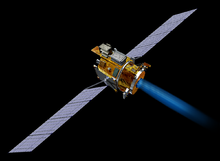Solar electric propulsion



Solar electric propulsion (SEP) refers to the combination of solar cells and electric thrusters to propel a spacecraft through outer space.[1] This technology has been exploited in a variety of spacecraft by the European Space Agency, the Japanese Space Agency, Indian Space Research Organisation and NASA.[1] SEP has a significantly higher specific impulse than normal chemical rockets, thus requiring less propellant mass to be launched with a spacecraft and it has been evaluated for missions to Mars.[2]
Overview
Solar electric propulsion combines solar panels on spacecraft and one or more electric thrusters, used in tandem. There are many different types of electric thrusters, including a so-called ion thruster, a term that is often incorrectly used to describe all types of electric thrusters.
It is also possible to generate electricity from the Sun without using photovoltaic panels, such as with solar concentrators and a Stirling engine.
A 50 kilowatt SEP system was studied in the 2010s for a mission to an asteroid.[3] In February 2012 NASA awarded a contract for a Solar Electric Propulsion Flight System .[4]
An example of work on this type of technology is Advanced Electric Propulsion System.[5]
The NASA Solar Technology Application Readiness (NSTAR) ion engine has been used with photovoltaic solar panels, which was tested on the Deep Space 1 mission along with Solar Concentrator Arrays (Launched in 1998 as part of the New Millennium Program) [6][7]
SEP has been studied as a technology for a mission to Mars.[8] In particular the high specific impulse of the ion engines could lower overall mass and avoid having to use nuclear technology for power when coupled with solar panels.[9] A 1998 study for SEP for a human mission suggest that a human-sized spacecraft would need 600 to 800 kilowatts of electrical power coupled with ion engines with a specific impulse of 2000 to 2500 seconds.[10]
Mission examples
- BepiColombo mission to Mercury (launched) [11]
- Dawn asteroids mission (launched)
- Deep Space 1 asteroid and comet mission (launched)
- Hayabusa asteroid mission (launched)
- PSLV-C45 EMISAT Mission (launched)
- Asteroid Redirect Mission (cancelled)
- Lunar Gateway (proposed)
- Psyche asteroid mission (planned)
Electric propulsion technologies
- Resistojet rocket
- Ion thruster
- Pulsed plasma thruster
- Hall-effect thruster
- Magnetoplasmadynamic thruster
- Field-emission electric propulsion
- Variable Specific Impulse Magnetoplasma Rocket (VASMIR)
See also
- Batteries in space
- Liquid-propellant rocket
- List of spacecraft with electric propulsion
- Nuclear electric rocket
- Solar panels on spacecraft
- Solar sail
- Solar thermal rocket
- Sterling engine
References
- ^ a b Mohon, Lee. "Solar Electric Propulsion (SEP)". NASA. Retrieved 2016-04-24.
- ^ Solar Electric Propulsion for Mars Exploration NASA, 2005-01-08.
- ^ "Solar Electric Propulsion: NASA's engine to Mars and Beyond - SpaceFlight Insider". www.spaceflightinsider.com. Retrieved 2018-07-28.
- ^ "NASA Awards Solar Electric Propulsion Flight System Contract".
- ^ "Advanced Electric Propulsion System successfully tested at NASA's Glenn Research Center - SpaceFlight Insider". www.spaceflightinsider.com. Retrieved 2018-07-28.
- ^ "Advanced Technologies". NASA / Jet Propulsion Laboratory. Retrieved 20 November 2016.
- ^ "In Depth | Deep Space 1 – Solar System Exploration: NASA Science". Solar System Exploration: NASA Science. Retrieved 2018-08-08.
- ^ [1]
- ^ [https://ntrs.nasa.gov/archive/nasa/casi.ntrs.nasa.gov/20050181421.pdf
- ^ [2]
- ^ BepiColombo Fact Sheet European Space Agency, 2010-07-05.
